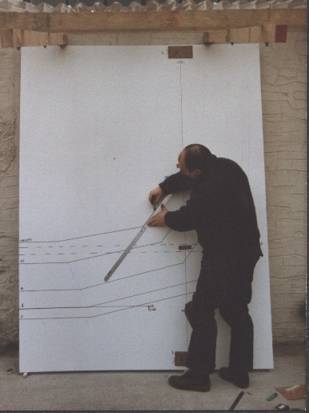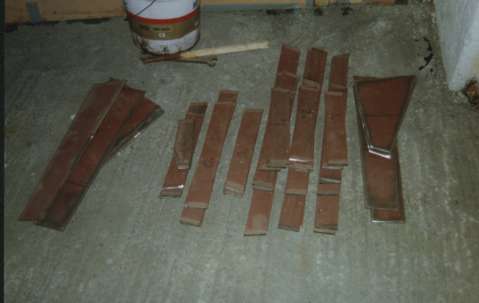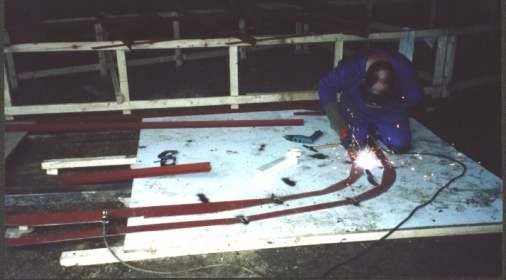Links
Fay Marine Photographs 1

Setting out the frames onto plywood. A table of offsets is easy to use on a chine or radius chine hull. One edge of the plywood is used as a centre line and the bottom as the base line. The measurements in the table are all up from the base line or out from the centre line. Where the two meet is a chine and a cross is made. It is then easy to join up the crosses and see the shape of the frame appear.
If it is decided to have a solid toe rail the height of the topsides is increased to include this. A headstock line is drawn for the bracing angle iron position.
I normally set out half the frames on one set of plywood ant the rest on another set to stop the frame lines overlapping and becoming confusing. Only one half needs setting out as it can just be used twice.
Once all the frames have been set out I cut stiff card to the width of the frame to make templates for each frame piece. These are pinned into position and the joints at each chine accurately cut across the corner.
These templates are then laid on the frame bar, the bar is marked for two pieces and cut.
On our radius chine Fay 40, a position is marked and from this a radius is drawn joining the topsides line to the lower plate.

Piles of frame pieces waiting to have holes drilled.
Once the ends have been cleaned and prepared for welding I always drill the inner edge with 3/16" (4mm) holes around every six inches and about 1/2" in from the edge.
This has several functions. First it is much easier to drill the frame pieces using a pillar drill before the frames and hull are assembled.
Second, the frame pieces can be temporarily screwed to the plywood during assembly which helps with accuracy and helps stop the frame distorting during welding.
Third it will save an enormous amount of time and effort later.

Two frames screwed to the plywood and being welded. Once one half has been made it is 'flipped' over and the other side constructed. The headstock can be used along with the beam measurement to ensure accuracy.
In the background can be seen a temporary timber building frame with, just visible, some frames laid on it ready for erection.
This is a radius chine yacht. Notice on the inside of the radius section the plate has been cut as two straight sections. This is to make fitting the plywood lining of the hull easier. A little forethought and time spent at this stage will save much effort and time later. I attempt to include this type of information in all of the Fay plans.
ŠPaul Fay 2004